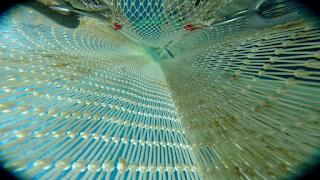Yesterday towards the evening whilst approaching Moray Firth we shot the net on some marks along the seabed. The haul contained young herring (around 18 cm mean length) and sprat (mean 11 cm).
 |
| trawl 5 (on 1.7., 16:34UTC @ 58.05N 2.30W) |
The multibeam echosounder is running throughout the survey and also during trawling, so we collected data on the schools we targeted. Lining up the multibeam data creates 3D images of the fish schools. Below are several examples of these viewed from different angles.
 |
| 3D views of fish schools based on the multibeam echosounder data |
 |
| the same scene of the 2 fish schools as seen in 3D and 2D |
 |
| combining different views for better data interpretation |
From the combination of the single beam EK60 and the multibeam ME70 we expect to improve school identification. It allows us to characterise the school shape whic
h may be different for different species. The crew on board the Tridens also use the information during catch operations to steer the net towards the schools.
 |
| Bram releasing one of the sharks we caught |
 |
gulls having a rest on the fore deck while we steam through the Moray Firth
Sascha getting his hands dirty
Haul 5. Mixed catch with 50% herring and 50% sprat
Bram and Sascha processing the catch
Sprat and young herring look very similar to one another. But there are a few tell them apart. The pelvic fins of the herring are behind the start of the back fin, whereas on the sprat they are in front.The herring has smooth gill covers, and moderately blunt keel scales along the edge of the belly, whereas the sprat has pointed keel scales that feel prickly when a finger is run along the belly.
Sascha explaining the morphological differences between sprat and herring
Juvenile Atlantic herring (Clupea harengus) with blunt keel.
European sprat (Sprattus sprattus) with jagged keel
A beautiful morning in Moray fifth (Thursday 2nd July)
Before every deployment of the net Dirk attaches a GoPro and light source to the top panel of the net. With this setup we aim to identify when a particular species enters the net which can then be linked to acoustic recordings to aid echotrace classification.
The way every good GoPro video begins
Footage from inside the net. Note the catshark on the left of the image.
A herring school being caught by the pelagic trawl
The net being hauled after an hour and a half in the water
|




















No comments:
Post a Comment